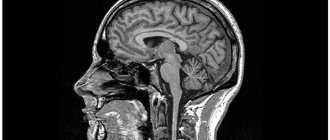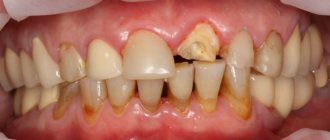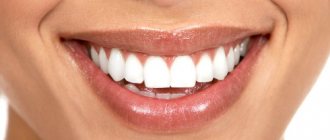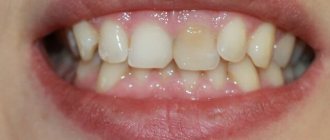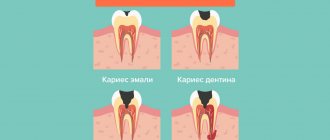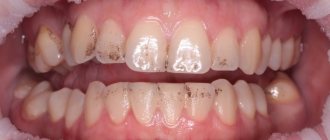Common reasons
Darkening of teeth can look different:
- If the discoloration is caused by plaque that is not properly removed, the color of the dentition appears uneven, darker at the base and lighter towards the edges; Possible causes are abuse of coffee and tea (strongly brewed drinks have a powerful coloring effect) and smoking. It is very difficult for tea, coffee and nicotine lovers to maintain a snow-white smile; they practically have to choose between beautiful teeth and established habits.
- If one or more teeth have a pronounced color difference, we have to talk about poor-quality canal treatment or the development of secondary caries (after removal of the nerve, the darkening of the tooth is explained by the lack of nutrition and is natural; a dark rim around the filling is a signal for its immediate replacement due to a violation of the tightness ). A tooth can also be darkened by trauma that causes nerve death or internal bleeding; whiteness can only be restored through careful treatment of the canals, sometimes with intracanal bleaching.
Black plaque is not only a death sentence for a smile, but also a possible cause of caries. Only regular visits to the dentist will help you avoid troubles and keep your teeth healthy and white.
Food gets under the crown: what to do
We have already said above that if there is an unpleasant odor from under the crown or food gets under the crown, these symptoms indicate the process of decay of the tooth tissue (carious tissue damage). No amount of rinsing or application can stop this process, and therefore, if you want to try to save the tooth, you need to urgently contact an orthopedic dentist.
It is only necessary to clarify that sometimes the smell from under the crown can be associated with the formation and suppuration of periodontal pockets. In this case, one of the symptoms may be redness of the gums around the crown, or there may be purulent discharge from periodontal pockets. It must be said that the formation of pockets near the crown occurs quite often, which can be associated both with prosthetic errors and due to poor oral hygiene.
Why do children's teeth turn black?
While many explanations can be found for the darkening of tooth enamel in adults, black teeth in a child cause bewilderment and confusion among parents. In fact, a child’s teeth can darken even with careful hygiene and in the absence of chronic diseases.
There are several reasons for the problem, the main one is improper nutrition with the amount of sweets in the diet: microbes, like people, love sweets, the effect of sweet food on tooth enamel is negative, associated with the appearance of a dense microbial biofilm. Other common reasons:
- genetic predisposition
- calcium deficiency
- dysbacteriosis
- early caries
If you notice dark gingival stripes on your child’s teeth, do not ignore them: the appearance of the so-called Priestley’s plaque is one of the consequences of the development of the digestive system, which resolves itself with age, but it is better to clarify the diagnosis with a dentist. Dark spots and dots on the baby’s teeth should also cause concern: contrary to the popular belief that baby teeth should not be treated, in the absence of adequate treatment, permanent ones that grow to replace them are often damaged.
Black teeth in a child are an alarming signal that requires an immediate preventive examination by a dentist, since all pathologies develop rapidly in childhood.
Why does a tooth rot under a crown?
The emergence of a pathological process occurs for a number of reasons. All of them are united by the same outcome - the penetration of pathological microorganisms. Among the most common causes of rotting are:
- Poor hygiene. If the patient does not keep his teeth clean and his oral cavity healthy, plaque accumulates on the teeth and tartar forms. These processes are accompanied by damage to the gums that protect the cervical part. The root of the tooth and the junction with the crown are exposed to destructive effects.
- Bad habits, unhealthy diet.
- Lack of calcium, bone tissue pathology.
- Secondary caries, decementation and food getting under the crown. Food rots, causing tooth decay.
Black teeth: treatment methods
What can you do at home?
It is well known that you can make your teeth lighter by quitting smoking and limiting your consumption of coloring drinks such as strong coffee and tea.
Another obvious requirement is regular brushing of teeth with the addition of additional dental hygiene products (dental floss, rinses, etc.)
On the Internet you can find many recommendations for changing the shade of tooth enamel using folk remedies, but you should not rely on such solutions, since only professional hygiene and whitening give real results. Don't self-medicate!
If you decide to see a dentist
At the first appointment, provide the specialist with as much information as possible about your health, lifestyle and bad habits - this will help the dentist quickly and accurately stop the cause of the pathology.
If the darkening is due to tooth decay, recent nerve removal, or other dental problems, treatment will be required. Today, dentistry fights for every tooth, offering solutions even in situations that seem hopeless, including restoring teeth with crowns or veneers.
The method of treatment is selected individually based on the general condition of the oral cavity.
Methods for solving the problem
The method of tooth restoration is chosen taking into account:
- causes of darkening of enamel and dentin,
- the patient has chronic diseases.
The following techniques are used in modern dentistry.
- Removing plaque and tartar. Professional oral hygiene can make the enamel 1-2 shades lighter and restore its smoothness.
- Endobleaching. It is carried out when there is discoloration of one or more pulpless teeth, as well as poorly performed prosthetics. The brightening gel is injected directly into the tooth canals.
- Restoration of the crown part of the tooth with composites and other materials. The doctor removes damaged tissue, treats the cavity, and restores the crown.
- Microprosthetics. Indicated in difficult cases when it is impossible to restore a darkened and damaged crown using other methods. It involves installing a crown made of metal-ceramics and other materials.
In rare cases, tooth extraction is recommended. It is shown if:
- the roots are damaged, there is a large crack on the crown,
- there is severe loosening of the tooth, inflammation of the gums,
- the inflammatory process affects not only soft tissues, but also the jaw bone.
After tooth extraction, a crown or implant can be installed.
Methods for treating black teeth
- If black streaks or stains appear on the teeth due to improper care, professional hygiene is prescribed. In our clinic you can sign up for a “denticure”, your teeth will be free of plaque, and your smile will be attractive again
- If your teeth are blackened due to food dyes, then professional or home whitening, using special toothpastes and eliminating coloring foods from your daily menu will help.
- If your teeth have turned black due to caries, then sanitation with further restoration of the tooth and preventive procedures to strengthen your teeth are necessary. No dentist will remove black teeth without understanding the cause.
Provide thorough and competent oral care - and you will never know what black plaque is. See a dental hygienist to learn how to properly brush your teeth and choose a toothbrush and toothpaste.
Causes of darkening of teeth
The condition of teeth is a reflection of nutrition, care, bad habits and other factors. If your teeth begin to darken, you need to consider a variety of reasons that could cause a change in the shade of the enamel. All the reasons why tooth enamel is darker are divided into external and internal.
External reasons
External causes mean processes occurring due to external influences on the teeth.
- Poor hygiene. Due to insufficient quality dental care, plaque remains on the enamel. Gradually, the deposits begin to compact and become more dense. If the plaque is exposed to dye, its pigment penetrates deep into the dense structure.
- Dyes. Tooth enamel weakened due to demineralization or bleaching becomes unstable to artificial and natural dyes. Changes in the color of teeth can occur with frequent consumption of foods with dyes (coffee, bright berries, vegetables and fruits, carbonated and alcoholic drinks, sweets, spices, etc.).
- Smoking. Black teeth are a common problem among smokers. The resins released when smoking a cigarette into the oral cavity are abundantly deposited on the enamel and adhere tightly to it.
Black plaque on teeth cannot be removed with a toothbrush or even whitening toothpaste. An aesthetic defect can only be eliminated using professional dental methods.
Internal reasons
External factors provoke mainly an aesthetic defect, but can cause an increased risk of dental diseases. Internal causes should be taken as seriously as possible, since they involve the impact of pathological processes on the teeth, which will only progress without appropriate treatment.
Internal factors that cause teeth to darken.
- Caries. The most common cause of darkening of tooth enamel. A distinctive feature is the change in color of one tooth. In rare cases, several adjacent teeth darken. Tooth decay can appear as a spot or cavity. If the cervical form of caries occurs, then the roots of the teeth darken, or more correctly, the root zone.
- Seal. Black teeth may be the result of fillings. Some types of composite contain substances that stain the dentin and crown. Modern dentistry does not use such materials, but if the tooth was filled more than 7-10 years ago, similar reasons cannot be ruled out.
- Metal insert. Metal is prone to oxidation, which can easily cause tooth enamel to darken.
- Metal crowns. The installation of classic metal crowns has such a defect as darkening of the tooth in the area of the marginal gum line. The appearance of blackness indicates an oxidation process, which causes the metal to be exposed to the acidic environment of the oral cavity.
- Injuries. The tooth is equipped with a large number of blood vessels, if damaged, blood can penetrate into the dentin. Due to the accumulation of blood under the crown, the process of breakdown of blood particles will affect the color of the tooth, which will change from red to blue-black.
- Depulpation. Removing the dental nerve entails many consequences. Including darkening of the enamel. The reason is a lack of nutrition to the tooth or the development of recurrent caries.
With the progression of internal causes, treatment is a mandatory step in restoring dental health and aesthetics. Depending on the pathology, the specialist determines ways to influence the pathological process.
Pigmented dark plaque on teeth
The main reason for the appearance of such plaque in adults is smoking, drinking coffee and tea. Maintaining hygiene guarantees the absence of bacterial plaque and tartar, but if you neglect it, black plaque will not take long to appear. Pigments adhere very well to enamel covered with bacterial plaque formed as a result of infrequent brushing of teeth.
Types of pigment plaque include:
- brown coating that occurs from regular consumption of tea and coffee in large quantities;
- accumulation of nicotine deposits;
- darkening of the enamel as a result of taking medications containing iron;
- proliferation of bacteria that form dyes (they are called chromogenic);
- change in enamel color after using antibiotics;
- blackening due to diseases of internal organs.
If plaque is caused by bacterial factors, then regular thorough brushing of teeth, the use of rinses and floss reduce the likelihood of its occurrence to a minimum. However, if the reason for the appearance of plaque lies in the influence of dyes, maintaining hygiene to prevent it will not help.
Black plaque on children's teeth , the causes of which are associated with the activity of chromogenic anaerobic bacteria, appears in the form of spots localized in the neck area. Actinomycete bacteria produce hydrogen sulfite, which reacts with iron (found in saliva and red blood cells). As a result, a form of black iron that cannot be cleaned off with a regular brush is deposited on the surface of the teeth. Chromogenic coloration can also be orange, green and brown.
Black plaque on a child’s teeth can also form for other reasons . It appears due to:
- the use of antiseptics that contain chlorhexidine, benzaclonium chloride, as well as essential oils (the latter are found in the popular Listerine product);
- consumption of foods rich in iron, as well as vitamins with a high content of iron.
